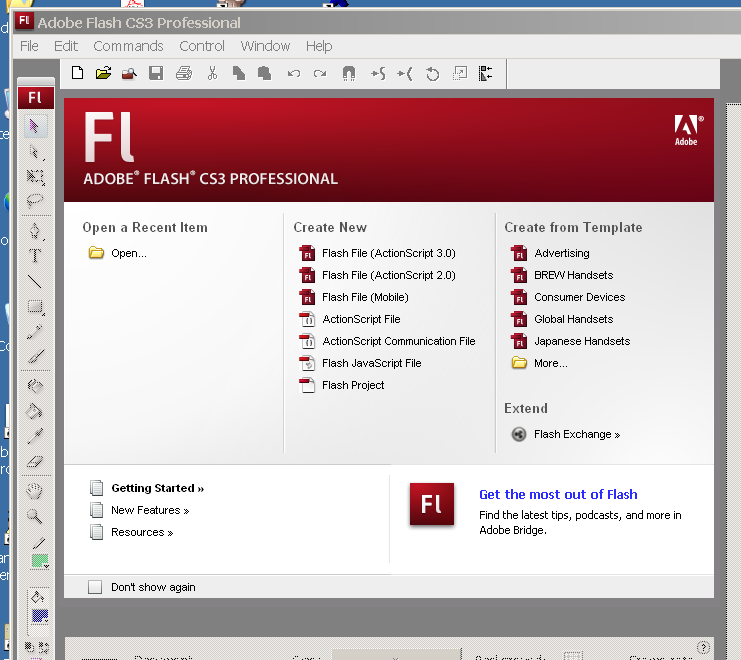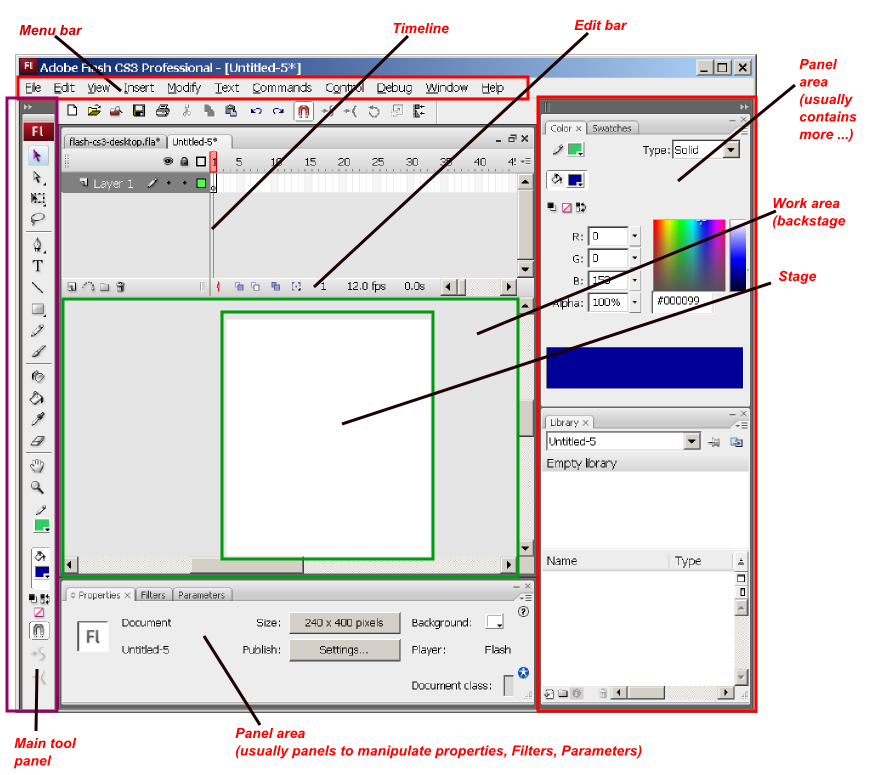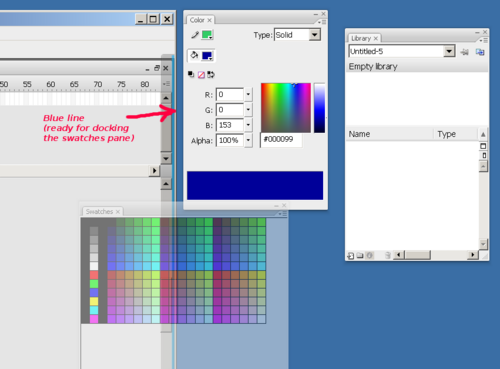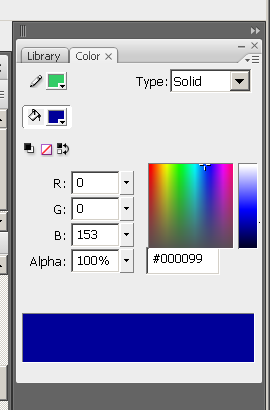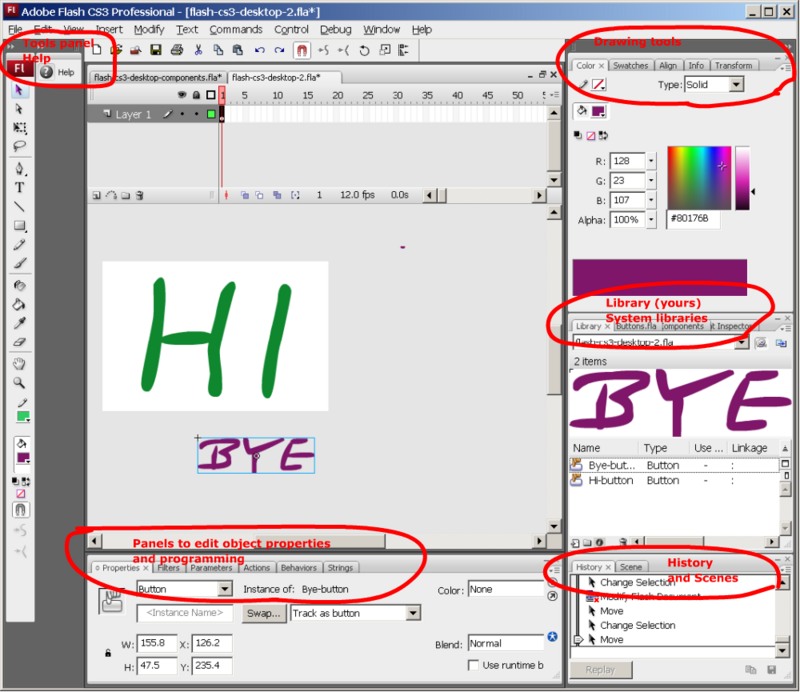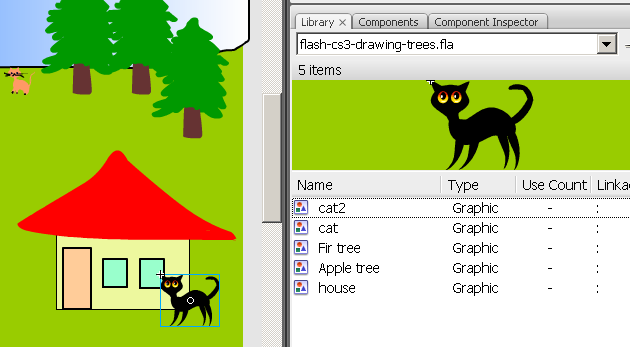Flash CS3 desktop tutorial: Difference between revisions
m (→Definition) |
|||
| Line 205: | Line 205: | ||
=== Toolbars and Panels === | === Toolbars and Panels === | ||
We will introduce panels as we need them in other tutorials except one, the ''library'': It contains all the objects you use in a Flash document. | |||
For example, in the [[flash drawing tutorial]] we used five different reusable objects, in more technical terms these drawings were '''graphic symbols'''. Once you defined something as symbol (either graphic, button or movie clip) you can reuse these as many times as you like in a flash document. | |||
[[image:flash-cs3-library-panel.png]] | |||
Revision as of 16:34, 7 August 2007
This article or section is currently under construction
In principle, someone is working on it and there should be a better version in a not so distant future.
If you want to modify this page, please discuss it with the person working on it (see the "history")
<pageby nominor="false" comments="false"/>
Definition
This is part I of Flash tutorials.
Learning goals:
- Learn about various components of the Flash Desktop
- Learn how to configure/save the Desktop
Next steps:
The Flash Welcome Screen
When you launch Flash you see a welcome screen. It looks like this:
To start working, you now can now use either the File Menu or click on an item in the welcome screen. E.g.
- From File->Open open for example a *.fla file you are working on
- Open a "recent" item either through the File Menu or the button
- Create a new Flash file
- ...
If you tick Don't show again you won't see this anymore, but the same options are available through the File Menu. If you want it back: Edit->Preferences.
For now, we suggest to click on Flash File (ActionScript 2.0). This way you can use built-in behaviors (i.e. do some action script without programming). Flash File (Action Script 3.0) does not support this. You can changer the settings later again in any case.
Now you really entered the Flash Desktop working environment.
Read on...
Layout of the Flash Desktop
By Flash Desktop (Desktop in short) we mean the whole authoring environment that you can see when you work on some Flash animation.
The default desktop
When you first open a the Flash Desktop you may not see all the tools. It should look a bit like this (I am not so sure about the right-hand side panel area).
The annotated screentop already conveys an idead of the kinds of tools you get, but we will introduce them later.
You can arrange the Flash Desktop in various ways (see below), but for the rest of this tutorial I will try to stay with a somewhat stable environment
Configuring the desktop layout
Before we explaining some components I suggest that learn how to arrange your Desktop.
Firstly, we'd like make visible some more panels (tools and libraries). Having tools at your fingertip is IMHO always a good idea if your screen is big enough. BTW, if you can afford to buy CS3 maybe it's also a good idea to invest in screen that can do 1900x1200 pixels....
- Show the tools panel (if hidden by mistake)
You always need the main drawing tool panel (leave it to the left). You then can add two other tools panels that include some of the most commonly used menu commands.
So display all the toolbars
- Window->Toolbar
- Check/tick all three, i.e. Main, Controller, Edit Bar.
- Adding and moving panels
Panels are tools and libraries that contain functionalities. Some of these you can't find in any menu, therefore at some point you have to learn what kind of panels exist. Btw, if at some point you can't see panels you think you put on the desktop, hit F4 or Window->Show Panels)
Now let's see how you can organize the workspace. CS3 lets you arrange panels in various ways:
- They can be floating (undocked, usually you would move them outside the Flash Desktop)
- They can be docked to either panel area to the right, to the bottom or even to the left.
- They can be docked in groups of panels (each one will show as a tab)
To dock a panel, simply grab it with the mouse (press the left-mouse button on a empty area in its top bar) and then drag it to an "place" that will "light up" in some light blue color.
- If you see a blue line (vertical or horizontal) and release the mouse it will dock below or to the right as a lone panel
- If it's a blue top bar of another panel it will dock next to the other panel with a tab
The two screenshots below should illustrate the principle:
- Docking against a line example
The Swatches panel is being dragged to the (emtpy and therefore reduced right hand panel area. There is a faint blue vertical line. Note, that you also may encounter horizontal blue lines against which you can dock ...
- Docking together with an other panel example
The Color panel is in the process of being docked together with the libary panel. It's top bar is light blue, i.e. ready for docking (see also the next picture) ...
Now is firmly docked as a "tab" grouped together with the library panel
- To undock a panel
Drag it to some place that doesn't light blue.
Saving an environment
To make sure to find an environment again you may save it under a given name. This is also useful if you do different kind of work with Flash.
- Window->Workspace->Save Current ...
If you are happy with what you did, save your configuration now ...
An example configuration
Here is an example configuration Daniel K. Schneider 18:53, 4 August 2007 (MEST) is using. I like to have most tools at my fingertips and I have a big enough screen for this. My real workspace is bigger though. I just resized the window in both dimensions in order to avoid a too large screen capture.
But of course, you also my choose to work with less visible panels and only open them when you need them, like in the following example you can enlarge if you whish. Finally, you may save different configurations for different kinds of work you do...
Built-in and online Help
There is two sorts of support:
- Built-in help
- Help from Adobe's website
Built-in Help is quite good, altough contextual help could be better (like being a systematic option on the right-click menu).
For some stuff you can get context-dependent i.e. learn something about certain objects, an item, etc. It will open a more or less appropriate section in the help tree. Select this item first (e.g. in the Workspace or in a panel), then either get Help from the Menu / hit F1 / or click on the little help action in for instance the properties panel.
In addition, in the help menu you can find links to external sites. It doesn't work for me, maybe because my default browser is Firefox.
Within the built-in help texts there are also links to Adobe on-line resources, but do not necessarily work as they should (e.g. the link www.adobe.com/go/learn_fl_tutorials doesn't lead to a text tutorial as advertized. Quite typical of Adobe on-line support I should say.
However there is good stuff on Adobe's website, e.g.
- the video tutorials are truly useful to beginners:
- Video tutorials at Adobe
- The overal Flash Help page
- Flash resources
- In particular, you can find HTML and PDF versions of the build-in help. You may find HTML more practical than the internal help window since it can not be detached from the Flash workspace and will hide your workspace while your reading. An other trick to be able to quickly open/close the built-in help is to dock it against the Main tool panel (as shown in the screen capture above). Finally, PDF can printed.
Moving on
In this chapter we will summarize the functionalities of some Flash components. We will introduce more functionalities in other planned tutorials.
The Work area and the stage
The stage in the middle (white by default) is where you work on your Flash contents. It is part of the work area. The grey part of the work area (also called backstage can contain graphic elements on which you are working and that you plan to integrate into the stage sometimes.
- Changing size of the stage
With Modify->Document you can:
- Redefine the size of the stage.
- Change the background color
- Give it a title, etc.
The Menu Bar
On top of the desktop is the menubar (on the Mac it will be on top of the screen of course). Flash let's do you things in three different ways:
- Interact through the menu
- Shortcut
- Interact through panels
Available interactions are context dependent, i.e. differ in function of what you are working on in the workspace and also in function of the Flash "Publish Setting" (e.g. ActionScript 2 vs. ActionScript 3).
Here is a short and incomplete summary of the menu groups' functionalities:
- File
- Opening and creating new files
- Definition of Publication Settings (you may change settings you initially defined)
- Edit
- Editing the scene
- Editing elements that are active
- View
- Define zoom level, grids, snapping (i.e. how the workspace displays)
- Other important "view" items are in the Windows menu
- Insert
- Add new layers, frames, symbols etc. into the timeline
- Add a new scene
- Modify
- Modify elements on the workspace, e.g. convert a graphic to a symbol (make it a reusable object) or change the shape of a drawing
- Modify timeline elements
- Text
- Change text properties
- Spell checking
- Commands
- Run macros
- XML export / import
- Control
- Test animation in various ways (including just sub-elements)
- Debug
- Tools to find errors in your scripts
- Window
- Configure the workspace (add/remove panels)
- Help
- Built-in help and links to useful on-line resources
Toolbars and Panels
We will introduce panels as we need them in other tutorials except one, the library: It contains all the objects you use in a Flash document.
For example, in the flash drawing tutorial we used five different reusable objects, in more technical terms these drawings were graphic symbols. Once you defined something as symbol (either graphic, button or movie clip) you can reuse these as many times as you like in a flash document.
